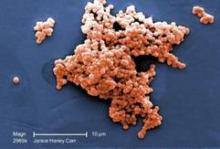Excessive evaluations of well-appearing neonates declined markedly, as intended, when the most recent (2010) CDC guidelines for assessing early-onset group B streptococcal sepsis were implemented, according to a report from one hospital published online Jan. 20 in Pediatrics.
This decrease was accompanied by a marked drop in health care costs and was not associated with any apparent harmful effects, indicating that the evaluations that were avoided were indeed unnecessary, said Dr. Sagori Mukhopadhyay of Boston Children’s Hospital and Harvard Medical School and her associates.
The guidelines from the Centers for Disease Control and Prevention (CDC) were revised so that healthy-appearing infants born to mothers who had inadequate intrapartum antibiotic prophylaxis for group B streptococcus would only be evaluated for early-onset GBS sepsis if they had additional indications: gestational age of less than 37 weeks, rupture of membranes that preceded delivery by 18 hours or longer, maternal fever, or chorioamnionitis. Preliminary studies indicated that implementing these more restrictive guidelines would decrease excessive evaluations of healthy newborns by approximately 25%, "but the real-life impact of changes in medical policy is rarely straightforward," the investigators said.
There was concern that some well-appearing infants who weren’t closely evaluated might go on to develop early-onset GBS sepsis that could have been prevented. So Dr. Mukhopadhyay and her colleagues performed a retrospective cohort study involving 14,286 live births to assess the effect of implementing the new guidelines.
They compared infants born at Brigham and Women’s Hospital, Boston, during two time periods: 7,282 born the year before the new guidelines were adopted (spring 2009–spring 2010), and 7,004 born the year afterward (spring 2011–spring 2012).
Typical evaluations for early-onset GBS sepsis involved immediate transfer to the neonatal intensive care unit, measurement of vital signs, blood sampling, peripheral IV catheter insertion, empiric antibiotic therapy, and close observation for several hours.
The number of such evaluations declined substantially after implementation of the new guidelines, from 920 to 476. This represents a rate decrease from 126 per 1,000 live births to 68 per 1,000 live births, the investigators reported (Pediatrics 2014;33:196-203).
The number of infants given empiric antibiotics also declined, from 527 to 365.
There was no increase in the number of infants who developed early-onset GBS sepsis between the two study periods. The overall rate of culture-confirmed infection was 0.25 per 1,000 live births in 2009-2010, which was not significantly different from the rate of 0.39 per 1,000 in 2011-2012.
Costs of care dramatically decreased along with the decline in "unnecessary" newborn evaluations. "The resources expended over the study periods among asymptomatic infants at risk for early-onset sepsis were considerable: more than 2,200 nursing hours were required to evaluate 1,396 infants, including 890 uninfected infants treated with antibiotics, at an estimated cost of nearly $400,000. These efforts detected only 2 early-onset sepsis cases," Dr. Mukhopadhyay and her associates said.
They added that the American Academy of Pediatrics’ Committee on the Fetus and Newborn recently published its own guidelines for early-onset sepsis evaluation and prevention. Because these AAP guidelines differ somewhat from the CDC guidelines, implementing them will likely have a somewhat different effect on the frequency and costs of such evaluations, the investigators said.
This study was supported by the National Institutes of Health, the Harvard Catalyst/Harvard Clinical and Translational Science Center, the National Center for Research Resources, the National Center for Advancing Translational Sciences, and Harvard University. No financial conflicts of interest were reported.


